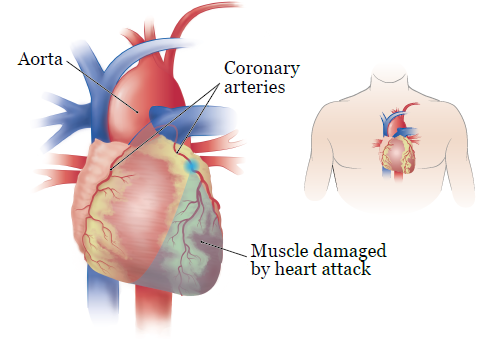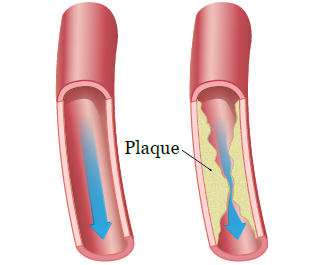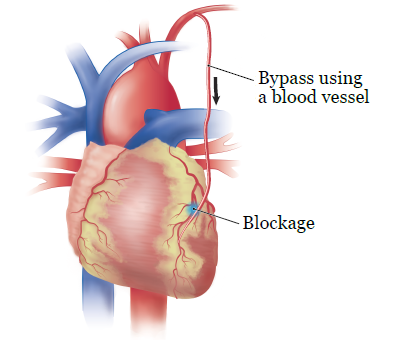This information explains heart attacks, including signs of a heart attack and how heart attacks are diagnosed and treated.
About Heart Attacks
A heart attack, also known as myocardial infarction (MI), happens when one of your coronary arteries (the blood vessels that carry blood to your heart muscle) becomes blocked. This can cause part of your heart muscle to weaken because blood can’t flow to it (see Figure 1). When part of your heart muscle is weakened, the heart muscle won’t work as well.

Common Signs of a Heart Attack
The following are signs of heart attack. You may have 1 or more of these signs.
- Pain, pressure, or discomfort in your chest
- Pain, tingling, or discomfort in your arms, back, neck, jaw, or stomach
- Having a hard time breathing while resting and when doing mild physical activity (such as walking a few blocks or climbing a flight of stairs)
- Wheezing (a whistling or squeaking sound when you breathe)
- Sweating
- Fast or uneven heartbeat
- Feeling dizzy or lightheaded
- Indigestion, a feeling of burning or discomfort in your upper abdomen (belly)
- Nausea (feeling like you’re going to throw up) with or without vomiting (throwing up). This is a common symptom of heart attacks in women.
If you think you’re having a heart attack, call 911 right away. Don’t drive yourself to the hospital. Emergency medical technicians (EMTs) can start treating you on the way to your closest emergency room.
Diagnosing a Heart Attack
There are many different tests to diagnose a heart attack. When you arrive at the emergency room, you may have 1 or more of the following tests.
Electrocardiogram (EKG)
An electrocardiogram measures the electrical activity of your heart. This means it measures things such as how fast your heart is beating, and many other things. During this test, your healthcare provider will place sensors (electrodes) on your chest, arms, legs, or all 3. The sensors will show how your heart is working.
Blood test
This blood test will look for a protein called troponin that’s released when your heart muscle is damaged.
Echocardiogram (echo)
An echocardiogram is an imaging test that uses ultrasound (sound waves) to take pictures of your heart. It shows how your heart is beating and pumping blood and can show if there’s anything wrong with your heart muscle or heart valves.
Stress test
A stress test helps doctors see if your heart is getting enough blood when you’re under stress, or when you do something that makes your heart work harder. For this test, you may get medications through an intravenous (IV) line (needle that’s put in your vein to give you medication) to raise your heart rate and blood pressure as if you were exercising, or you may be asked to exercise.
Cardiac catheterization (cardiac cath) and coronary angiogram
This is a procedure that shows if there are blockages in any of your coronary arteries.
You will be given medication to help you relax before the procedure. During the procedure, your healthcare provider will insert a thin catheter (long, flexible tube) into a blood vessel in your arm or leg and move it up to your heart. This is called cardiac catheterization or cardiac cath.
Once the end of the catheter is in your heart, your healthcare provider will put a special dye through the catheter into your heart. They will use an x-ray machine to watch the dye move out of your heart and see how it flows through your coronary arteries. This is called a coronary angiogram.
Treating and Preventing Heart Attacks
A heart attack can be treated with medication, cardiac catheterization, or surgery. Many of the following treatments may also prevent future heart attacks.
Medication
There are many types of medications used for treating and preventing heart attacks. These medications work in different ways. The following are some examples, but there are others. Your cardiologist (heart doctor) will talk with you about which is best for you.
Over-the-counter medications
- Aspirin. This medication helps to prevent your platelets from clumping (forming blood clots) and lowers the risk of death after a heart attack.
Prescription medications
- ACE inhibitors relax your blood vessels. This helps your heart work better after a heart attack and lowers your blood pressure. Examples include enalapril (Vasotec®) and lisinopril (Prinivil®).
- Anti-coagulant medications (blood thinners) such as heparin and enoxaparin (Lovenox®) thin your blood and prevent blood clots from forming.
- Anti-platelet medications (similar to aspirin) prevent blood clots from forming inside your arteries. These medications include clopidogrel (Plavix®), prasugrel (Effient®), and ticagrelor (Brilinta®). They can prevent re-blockage if you have stents placed. For more information about stents, read the Cardiac catheterization section below.
- Beta blockers slow your heart rate and lower your blood pressure. This helps reduce the amount of work your heart has to do. Examples are carvedilol (Coreg®) and metoprolol (Lopressor®).
- Nitrates widen your coronary arteries. This helps bring more blood to your heart muscle and reduces chest pain. Examples include nitroglycerin and isosorbide mononitrate (Imdur®).
- Statins lower your cholesterol. If you have too much cholesterol in your blood (high cholesterol), it can clog your arteries and make you more likely to have a heart attack. Statins reduce the fatty deposits (plaques) inside your arteries, lowering your risk of future heart attacks. Statins also help to secure any existing fatty deposits on the walls of your arteries and keep them from breaking off and causing a blockage. Examples include atorvastatin (Lipitor®) and rosuvastatin (Crestor®).
Procedures and surgeries
Sometimes, you may need more advanced care after a heart attack, including an angioplasty, stent placement, or surgery. If you have a heart attack while at Memorial Sloan Kettering (MSK) and need advanced care, you may need to be moved to another hospital. Your healthcare provider will talk with you about what treatment is best for you.
The following are procedures you may get after a heart attack.
Cardiac catheterization and coronary angiogram
During a cardiac catheterization, a small catheter is placed inside your artery. The catheter is placed in one of the arteries in your wrist (your radial artery) or one of the arteries at the top of your thigh (your femoral artery).

Your healthcare provider will put contrast dye (a dye used to help see your arteries more clearly) into your coronary arteries through the catheter to look for any blockages (see Figure 2). If they see blockages, your healthcare provider can do an angioplasty.
Coronary angioplasty and stent placement
During an angioplasty (also called a coronary angioplasty), your healthcare provider will place a thin catheter with a balloon at the end into the artery with the blockage. When the catheter reaches the blockage and is in place, your healthcare provider will inflate the balloon so it pushes outward against the wall of your artery (see Figure 3). This widens the artery and improves blood flow to your heart.

Your healthcare provider may also put a stent into your artery during this time. A stent is a hollow metal tube that keeps your artery open (see Figure 4).

Coronary artery bypass surgery

During coronary artery bypass surgery, your healthcare provider will take a blood vessel from another part of your body (such as your arm or leg) and attach it to your coronary artery above and below the blockage (see Figure 5). This lets your blood bypass (go around) the blockage.
Lifestyle Changes After a Heart Attack
The following are ways you can care for yourself after you’ve had a heart attack. Some are lifestyle changes that can help you avoid having another heart attack.
- If you’re a smoker, try to quit. MSK has specialists who can help you quit smoking. For more information about our Tobacco Treatment Program, call 212-610-0507 or ask your nurse for information about the program.
- If you’re overweight, try to lose weight. Talk with your healthcare provider about safe ways to do this.
- Follow a healthy diet that includes lots of fruits and vegetables. For more information, read the resource Eat Your Way to Better Health (www.mskcc.org/pe/eat_better_health) or talk with a clinical dietitian nutritionist.
- Talk with your primary care provider or cardiologist (heart doctor) about how to manage other health problems (such as high blood pressure, high cholesterol, and diabetes), if you have them.
- Join a cardiac rehabilitation program (program that helps improve the health and well-being of people who have heart problems). The program includes:
- Safe exercises for heart health.
- Education on ways to lower your risk of other heart problems.
- Counseling to lower stress. Stress can raise your risk for heart disease.
For more information and resources, you can also visit the American Heart Association website www.heart.org/en/health-topics/heart-attack/heart-attack-tools-and-resources/patient-information-sheets-heart-attack.